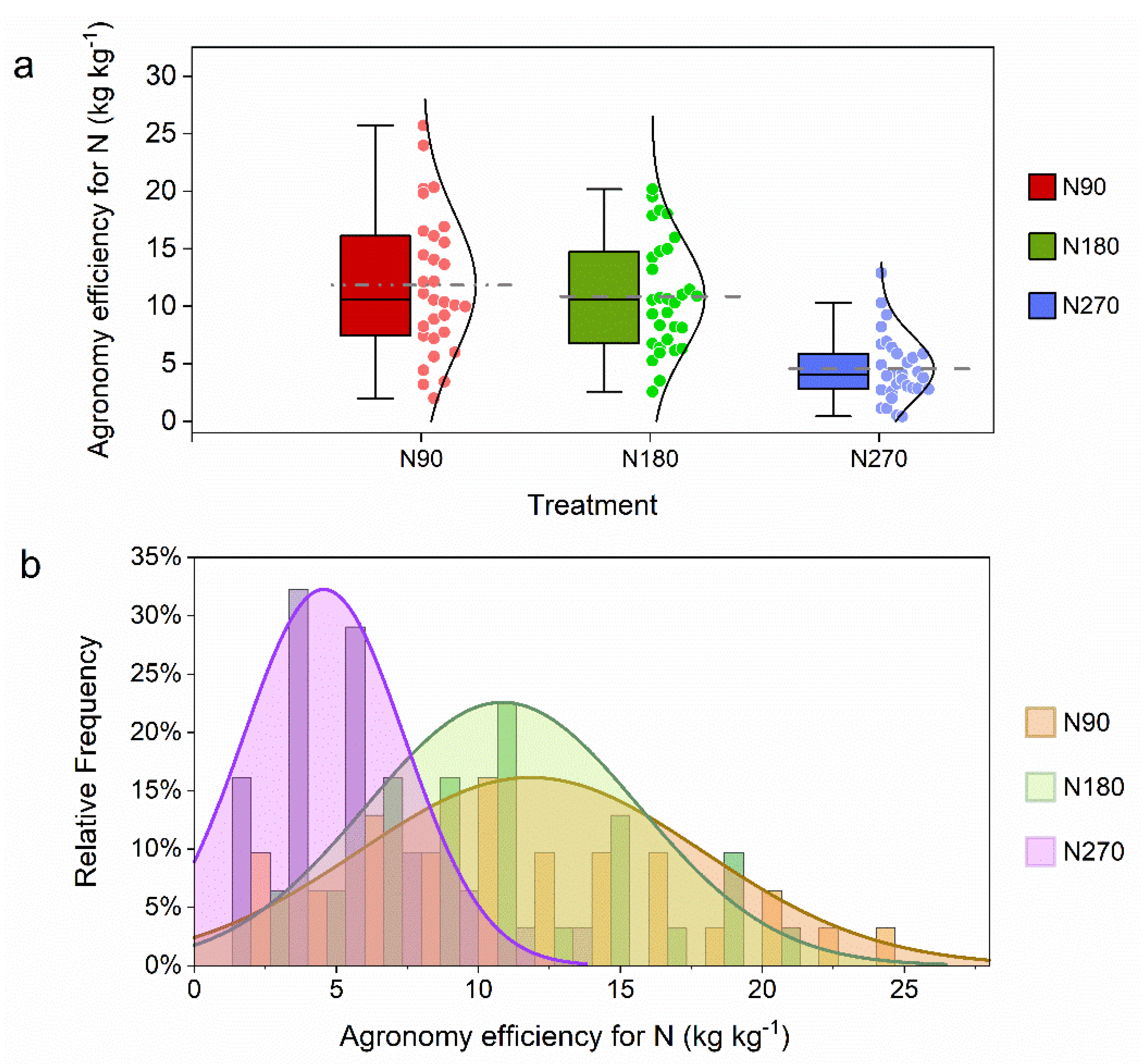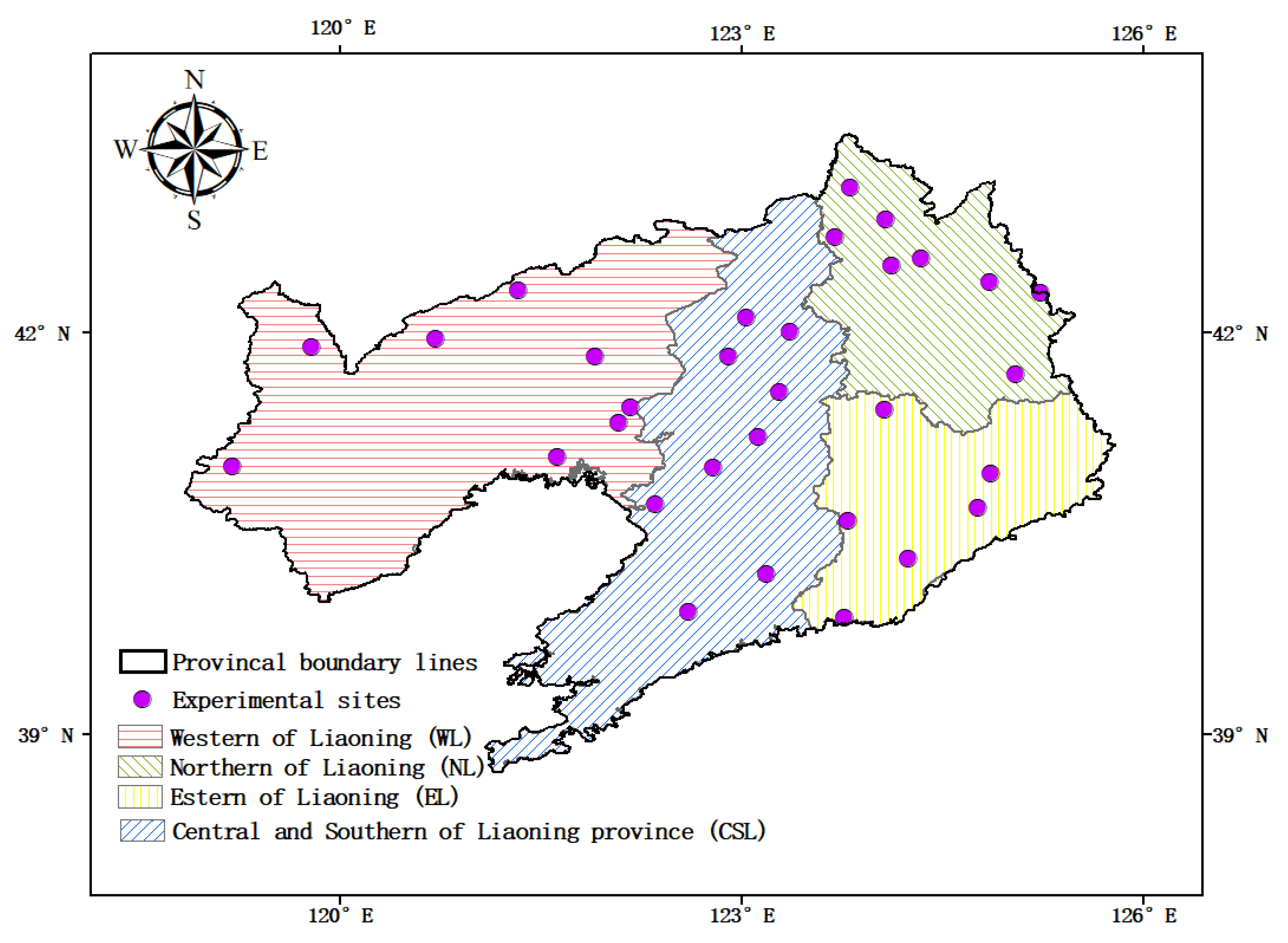Developing a Sustainable Management Strategy for Quantitative Estimation of Optimum Nitrogen Fertilizer Recommendation Rates for Maize in Northeast China
Abstract
:1. Introduction
2. Materials and Methods
2.1. Site Description
2.2. Experimental Design and Management
2.3. Sample Collection and Analysis
2.4. Fertilizer Effect Function Model
2.5. Calculations and Parameters
2.6. Statistical Analysis
3. Results and Discussion
3.1. Characteristics of Grain Yield and Yield Increasing Rate
3.2. Agronomy Efficiency for Nitrogen
3.3. The Regression Coefficient of Quadratic Model of Nitrogen Fertilizers in Maize
3.4. Optimum Nitrogen Fertilizer Recommendation Rates for Maize in Liaoning Province
3.5. Spatial Distribution of the Optimum Nitrogen Fertilizer Recommendation Rates and Corresponding Theoretical Yields
4. Conclusions
Author Contributions
Funding
Conflicts of Interest
References
- Foley, J.A.; Navin, R.; Brauman, K.A.; Cassidy, E.S.; Gerber, J.S.; Matt, J.; Mueller, N.D.; Christine, O.C.; Ray, D.K.; West, P.C. Solutions for a cultivated planet. Nature 2011, 478, 337–342. [Google Scholar] [CrossRef] [PubMed] [Green Version]
- Lu, C.; Lan, F. Winter wheat yield potentials and yield gaps in the North China Plain. Field Crop Res. 2013, 143, 98–105. [Google Scholar] [CrossRef] [Green Version]
- Guilpart, N.; Grassini, P.; Sadras, V.O.; Timsina, J.; Cassman, K.G. Estimating yield gaps at the cropping system level. Field Crop Res. 2017, 206, 21–32. [Google Scholar] [CrossRef] [PubMed]
- Tilman, D.; Cassman, K.G.; Matson, P.A.; Naylor, R.; Polasky, S. Agricultural sustainability and intensive production practices. Nature 2002, 418, 671–677. [Google Scholar] [CrossRef] [PubMed]
- Tester, M.; Langridge, P. Breeding technologies to increase crop production in a changing world. Science 2010, 327, 818–822. [Google Scholar] [CrossRef]
- Godfray, H.C.; Beddington, J.R.; Crute, I.R.; Haddad, L.; Lawrence, D.; Muir, J.F.; Pretty, J.; Robinson, S.; Thomas, S.M.; Toulmin, C. Food security: The challenge of feeding 9 billion people. Science 2010, 327, 812. [Google Scholar] [CrossRef] [Green Version]
- Qi, J.Y.; Yang, S.T.; Xue, J.F.; Liu, C.X.; Du, T.Q.; Hao, J.P.; Cui, F.Z. Response of carbon footprint of spring maize production to cultivation patterns in the Loess Plateau, China. J. Clean. Prod. 2018, 187, 525–536. [Google Scholar] [CrossRef]
- Ning, T.Y.; Zheng, Y.H.; Han, H.F.; Jiang, G.M.; Li, Z.J. Nitrogen uptake, biomass yield and quality of intercropped spring- and summer-sown maize at different nitrogen levels in the North China Plain. Biomass Bioenergy 2012, 47, 91–98. [Google Scholar] [CrossRef]
- Pordesimo, L.O.; Hames, B.R.; Sokhansanj, S.; Edens, W.C. Variation in corn stover composition and energy content with crop maturity. Biomass Bioenergy 2005, 28, 336–374. [Google Scholar] [CrossRef]
- Wang, X.; Li, Z.; Xing, Y. Effects of mulching and nitrogen on soil temperature, water content, nitrate-N content and maize yield in the Loess Plateau of China. Agric. Water Manag. 2015, 161, 53–64. [Google Scholar]
- Yang, Q.L.; Liu, P.; Dong, S.T.; Zhang, J.W.; Zhao, B. Effects of fertilizer type and rate on summer maize grain yield and ammonia volatilization loss in northern China. J. Soil Sediments 2019, 19, 2200–2211. [Google Scholar] [CrossRef]
- Pan, J.; Zhang, L.; He, X.; Chen, X.; Cui, Z. Long-term optimization of crop yield while concurrently improving soil quality. Land Degrad. Dev. 2019, 30, 897–909. [Google Scholar] [CrossRef]
- Zhao, D.; Reddy, K.R.; Kakani, V.; Read, J.; Carter, G. Corn (Zea mays L.) growth, leaf pigment concentration, photosynthesis and leaf hyperspectral reflectance properties as affected by nitrogen supply. Plant Soil 2003, 257, 205–218. [Google Scholar] [CrossRef]
- Clark, M.S.; Horwath, W.R.; Shennan, C.; Scow, K.M.; Lantni, W.T.; Ferris, H. Nitrogen, weeds and water as yield-limiting factors in conventional, low-input, and organic tomato systems. Agric. Ecosyst. Environ. 1999, 73, 257–270. [Google Scholar] [CrossRef]
- Xu, X.; He, P.; Pampolino, M.F.; Johnston, A.M.; Qiu, S.; Zhao, S.; Chuan, L.; Zhou, W. Fertilizer recommendation for maize in China based on yield response and agronomic efficiency. Field Crop Res. 2014, 157, 27–34. [Google Scholar] [CrossRef]
- Wang, X.; Fan, J.; Xing, Y.; Xu, G.; Wang, H.; Deng, J.; Wang, Y.; Zhang, F.; Li, P.; Li, Z. The Effects of Mulch and Nitrogen Fertilizer on the Soil Environment of Crop Plants. In Advances in Agronomy; Sparks, D.L., Ed.; Academic Press: Cambridge, MA, USA, 2019. [Google Scholar]
- Guo, J.; Wang, Y.; Fan, T.; Chen, X.; Cui, Z. Designing corn management strategies for high yield and high nitrogen use efficiency. Agron. J. 2016, 108, 922–929. [Google Scholar] [CrossRef]
- Chen, X.P.; Cui, Z.L.; Vitousek, P.M.; Cassman, K.G.; Matson, P.A.; Bai, J.S.; Meng, Q.F.; Hou, P.; Yue, S.C.; Römheld, V. Integrated soil–crop system management for food security. Proc. Natl. Acad. Sci. USA 2011, 108, 6399–6404. [Google Scholar] [CrossRef] [Green Version]
- Sebilo, M.; Mayer, B.; Nicolardot, B.; Pinay, G.; Mariotti, A. Long-term fate of nitrate fertilizer in agricultural soils. Proc. Natl. Acad. Sci. USA 2013, 110, 18185–18189. [Google Scholar] [CrossRef] [Green Version]
- Li, Z.; Han, X.; Cheng, F.; Liu, X.; Yang, J.; Wang, S. Study on fertilizer recommendation for corn in the south central of Liaoning province. Liaoning Agric. Sci. 2010, 4, 6–11. (In Chinese) [Google Scholar]
- Liu, M.Q.; Yu, Z.R.; Liu, Y.H.; Konijn, N.T. Fertilizer requirements for wheat and maize in China: The QUEFTS approach. Nutr. Cycl. Agroecosyst. 2006, 74, 245–258. [Google Scholar] [CrossRef] [Green Version]
- Jiang, W.T.; Liu, X.H.; Qi, W.; Xu, X.N.; Zhu, Y.C. Using QUEFTS model for estimating nutrient requirements of maize in the Northeast China. Plant Soil Environ. 2017, 63, 498–504. [Google Scholar]
- Doberman, A.; Pcs, C.; Cassman, K.G. Fertilizer inputs, nutrient balance, and soil nutrient-supplying power in intensive, irrigated rice systems. I. Potassium uptake and K balance. Nutr. Cycl. Agroecosyst. 1996, 46, 1–10. [Google Scholar] [CrossRef]
- Jiang, W.T.; Liu, X.H.; Wang, Y.; Zhang, Y.; Qi, W. Responses to potassium application and economic optimum K rate of maize under different soil indigenous K supply. Sustainability 2018, 10, 2267. [Google Scholar] [CrossRef] [Green Version]
- Chuan, L.M.; Zheng, H.G.; Sun, S.F.; Wang, A.L.; Liu, J.P.; Zhao, T.K.; Zhao, J.J. A Sustainable Way of Fertilizer Recommendation Based on Yield Response and Agronomic Efficiency for Chinese Cabbage. Sustainability 2019, 11, 4368. [Google Scholar] [CrossRef] [Green Version]
- Ladha, J.K.; Pathak, H.; Krupnik, T.J.; Six, J.; van Kessel, C. Efficiency of fertilizer nitrogen in cereal production: Retrospects and prospects. Adv. Agron. 2005, 87, 85–156. [Google Scholar]
- Zhao, P.F.; Cao, G.X.; Zhao, Y.; Zhang, H.Y.; Chen, X.P.; Li, X.L.; Cui, Z.L. Training and Organization Programs Increases Maize Yield and Nitrogen-Use Efficiency in Smallholder Agriculture in China. Agron. J. 2016, 108, 1944–1950. [Google Scholar] [CrossRef]
- Setiyono, T.D.; Walters, D.T.; Cassman, K.G.; Witt, C.; Dobermann, A. Estimating maize nutrient uptake requirements. Field Crops Res. 2010, 118, 158–168. [Google Scholar] [CrossRef]
- Chuan, L.; Ping, H.; Pampolino, M.F.; Johnston, A.M.; Jin, J.; Xu, X.; Zhao, S.C.; Qiu, S.J.; Zhou, W. Establishing a scientific basis for fertilizer recommendations for wheat in China: Yield response and agronomic efficiency. Field Crop Res. 2013, 140, 1–8. [Google Scholar] [CrossRef]
- Dobermann, A. Nutrient use efficiency: Measurement and management. In Fertilizer Best Management Practice: General Principles, Strategy for their Adoption and Voluntary Initiatives vs. Regulations. In Proceedings of the IFA International Workshop on Fertilizer Best Management Practices, Brussels, Belgium, 7–9 March 2007; Krauss, A., Isherwood, K., Heffer, P., Eds.; International Fertilizer Industry Association: Paris, France, 2007; pp. 1–28. [Google Scholar]
- Xu, X.; He, P.; Zhang, J.; Pampolino, M.F.; Johnston, A.M.; Zhou, W. Spatial variation of attainable yield and fertilizer requirements for maize at the regional scale in China. Field Crop Res. 2017, 203, 8–15. [Google Scholar] [CrossRef]
- Ziadi, N.; Cambouris, A.N.; Nyiraneza, J.; Nolin, M.C. Across a landscape, soil texture controls the optimum rate of N fertilizer for maize production. Field Crops Res. 2013, 148, 78–85. [Google Scholar] [CrossRef]
- Wang, X.; Fan, J.; Xing, Y.; Xu, G.; Wang, H.; Deng, J.; Wang, Y.; Zhang, F.; Li, P.; Li, Z. The Effects of Mulch and Nitrogen Fertilizer on the Soil Environment of Crop Plants. Adv. Agron. 2019, 153, 121–173. [Google Scholar]





| Statistics | (Y = aN2 + bN + c) Coefficients for the Quadratic Model of Grain Yield to N Fertilizer Application | ||
|---|---|---|---|
| a | b | c | |
| Average | –0.056 | 20.04 | 7859.8 |
| SD | 0.017 | 6.71 | 1159.0 |
| Minimum | −0.096 | 9.05 | 5254.5 |
| 25% quartile | −0.063 | 14.03 | 6865.0 |
| Mean | −0.057 | 19.15 | 7935.0 |
| 75% quartile | −0.044 | 24.63 | 8833.0 |
| Maximum | −0.026 | 35.28 | 10069.1 |
| Statistics | Optimum N Fertilizer Recommendation Rate (kg ha −1) | The Predicted Optimum Yield (kg ha −1) |
|---|---|---|
| Average | 180.4 | 9699.1 |
| Mean | 183.8 | 9892.6 |
| SD | 24.1 | 1041.6 |
| Min | 136.0 | 7908.7 |
| 25% quantile | 165.0 | 8850.0 |
| 75% quantile | 195.3 | 10468.5 |
| Max | 248.1 | 12153.9 |
| Region | statistics | Y = aN2 + bN + c Coefficients for the Quadratic Model of Grain Yield to N Fertilizer Application | Optimum N Fertilizer Recommendation Rates (kg ha −1) | The Predicted Optimum Yield (kg ha −1) | ||
|---|---|---|---|---|---|---|
| a | b | c (kg ha −1) | ||||
| WL (Western Liaoning province) | Average | −0.055 | 20.12 | 6890 | 184.2 | 8785.3 |
| Min | −0.071 | 12.07 | 5255 | 145.6 | 7908.7 | |
| 25%Qa | −0.063 | 14.03 | 6493 | 165.0 | 8242.3 | |
| 75%Qa | −0.047 | 24.63 | 6990 | 194.8 | 9276.0 | |
| Max | −0.032 | 29.78 | 8909 | 248.1 | 10326.2 | |
| SCL (Southern and central Liaoning province) | Average | −0.054 | 19.06 | 8914 | 177.2 | 10630.3 |
| Min | −0.096 | 9.05 | 7242 | 136.0 | 9138.5 | |
| 25%Q | −0.062 | 12.25 | 8351 | 159.7 | 10331.3 | |
| 75%Q | −0.034 | 24.32 | 9420 | 196.1 | 11104.3 | |
| Max | −0.026 | 35.28 | 10069 | 211.7 | 12153.9 | |
| EL (Eastern Liaoning province) | Average | −0.052 | 16.50 | 8015 | 163.5 | 9347.0 |
| Min | −0.084 | 12.17 | 7590 | 139.8 | 8899.9 | |
| 25%Qa | −0.075 | 12.20 | 7657 | 143.1 | 8957.1 | |
| 75%Qa | −0.034 | 23.22 | 8492 | 188.5 | 9750.5 | |
| Max | −0.031 | 25.68 | 8678 | 196.2 | 9821.4 | |
| NL (Northern Liaoning Province) | Average | −0.065 | 24.83 | 7549 | 192.5 | 9942.4 |
| Min | −0.085 | 17.43 | 7082 | 175.1 | 9328.0 | |
| 25%Qa | −0.078 | 20.51 | 7154 | 182.7 | 9610.3 | |
| 75%Qa | −0.053 | 29.30 | 8092 | 201.8 | 10297.0 | |
| Max | −0.045 | 33.21 | 8206 | 208.2 | 10468.5 | |
© 2020 by the authors. Licensee MDPI, Basel, Switzerland. This article is an open access article distributed under the terms and conditions of the Creative Commons Attribution (CC BY) license (http://creativecommons.org/licenses/by/4.0/).
Share and Cite
Jiang, W.; Xing, Y.; Wang, X.; Liu, X.; Cui, Z. Developing a Sustainable Management Strategy for Quantitative Estimation of Optimum Nitrogen Fertilizer Recommendation Rates for Maize in Northeast China. Sustainability 2020, 12, 2607. https://doi.org/10.3390/su12072607
Jiang W, Xing Y, Wang X, Liu X, Cui Z. Developing a Sustainable Management Strategy for Quantitative Estimation of Optimum Nitrogen Fertilizer Recommendation Rates for Maize in Northeast China. Sustainability. 2020; 12(7):2607. https://doi.org/10.3390/su12072607
Chicago/Turabian StyleJiang, Wenting, Yingying Xing, Xiukang Wang, Xiaohu Liu, and Zhigang Cui. 2020. "Developing a Sustainable Management Strategy for Quantitative Estimation of Optimum Nitrogen Fertilizer Recommendation Rates for Maize in Northeast China" Sustainability 12, no. 7: 2607. https://doi.org/10.3390/su12072607
APA StyleJiang, W., Xing, Y., Wang, X., Liu, X., & Cui, Z. (2020). Developing a Sustainable Management Strategy for Quantitative Estimation of Optimum Nitrogen Fertilizer Recommendation Rates for Maize in Northeast China. Sustainability, 12(7), 2607. https://doi.org/10.3390/su12072607






